
Faber-Castell has released a “Design Pencil” that is indeed the embodiment of design.
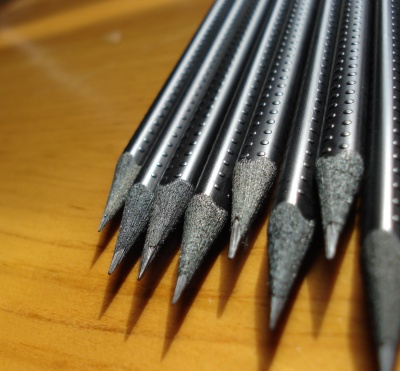
It is a fantastically good looking black triangular pencil, with black dyed wood. Like it’s elder cousin, the Grip 2001, it has raised dots on the side, though here they are smaller and beneath the surface paint. Markings are thankfully kept to a minimum, with only “Faber-Castell” and a small logo written on one side in grey.

In a B grade, it is very pleasant to hold and use. The lead is very strong and non-crumbling.
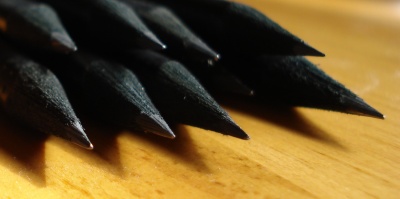
While I like Nava‘s pencils for appearance, this new creation has again demonstrated Faber-Castell’s industry leadership and ability to keep taking pencil design and presentation to higher levels.
Kita-Boshi HIT No. 9900 pencil
 While Mitsubishi, Tombow, and Pentel may be better known in the west, there is at least one more quality Japanese pencil manufacturer of note: Kita Boshi.
While Mitsubishi, Tombow, and Pentel may be better known in the west, there is at least one more quality Japanese pencil manufacturer of note: Kita Boshi.
The Japanese pencil industry website tells me of many other companies in the industry, but Kita-Boshi are the only one of these whose products I have been able to source.
I am not sure what is going on, because two different grades of the HIT No. 9900 appear to be different pencils, despite the same name and model number.
The 4B is round with an unfinished cap, and black with gold stamping. There is a gold band near the cap. It has these markings:
Obverse: Kita-Boshi HIT [8 Japanese Characters] 4B
Reverse: For Draftmen, Designers, Copy-writers No. 9900 4B
The HB is hexagonal, with colourings I have never seen in a pencil: Brown with gold stamping, and a green band near the cap.
It is marked:
Obverse: Highest Quality * KITABOSHI * HIT * HB
Reverse: For Retouching & Special Drawing No. 9900 HB
Another difference: The 4B core is approximately 50% wider than the HB core.
I can imagine the sincere but slightly awkward slogan “For Draftmen, Designers, Copy-writers” being enjoyed by many, though less so by Draftsmen and Draftswomen.
Both pencils, like the Pentel, have matte rather than glossy finishes. This is fine with me, and is quite pleasing. It is a quality finish, while being quite practical.
Both pencils sharpen easily, and lay down rich smooth dark lines. The 4B is almost unique as far as I know in being a round pencil at that grade. Its wide core, good looks, and quality graphite would truly make it a “hit” if it was more widely available.
The HB is very good in its category. The standards of Japanese woodcase pencils are very high, and this pencil doesn’t disappoint. It looks good, writes well, and while not as rich as the Mono 100 or Hi-Uni, still lays down a line better than most pencils.
Pentel Black Polymer 999

In addition to Tombow and Mitsubishi, there are other quality Japanese pencil manufacturers. One of these is Pentel. Their top of the line pencil in the Black Polymer series is the 999 alpha. I’ve heard they are great, but have been unable to acquire any. (If you have some for sale, please let me know!) But, I did come across some of their still very fine 2nd rank pencil, the 999.
Distinguishing the two pencils is easy – the 999 alpha has the Greek alpha character in the pencil name, and the slogan “supreme quality for lines of highest density.” It has a glossy finish with the grade printed in black on a silver background. The regular 999 has the more modest slogan “the highest quality for general use”, and less use of silver. The finish is matte, and the top of the cap is painted silver.
Matte vs. glossy sounds like a photo finishing or interior wall paint choice. But it seems it’s also a pencil choice, and Pentel chose matte for the 999. It is very pleasant to hold, looks good, and is not too common in pencils. I have some Lyra pencils with a similar finish, and can’t think of any other manufacturers that have chosen this type of finish. The silver accents on black paint make it one of the most attractive on the market – up there with the Grip 2001 and Nava.
The box it comes in also looks nice for a cardboard box – there is something very adult and stylish about the presentation.
The pencils sharpen easily. The lead is not as rich as that of the other Japanese pencils mentioned here, but still nicer than average. It makes an excellent writing pencil, and goes very nicely with a black journal.
Tombow Mono 100 Photos
To complement a previous post on the Mitsubishi Hi-Uni, here are some photos of another pencil legend, the Tombow Mono 100.
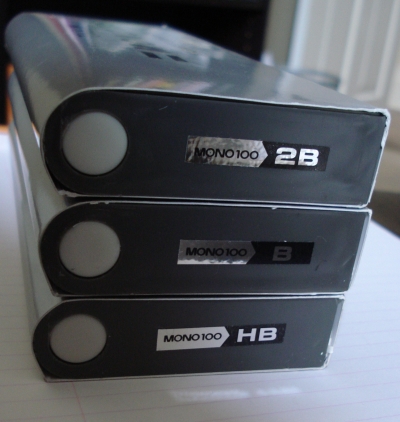
The packaging has an outer layer – a silver and black cardboard sleeve. One end is fully rounded, which is not really that much of a flourish, but still untypical. It’s no ordinary pencil box.
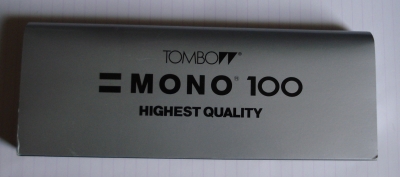
The case is black with a silver lid. The lid has a clear window, showing the pencils inside.
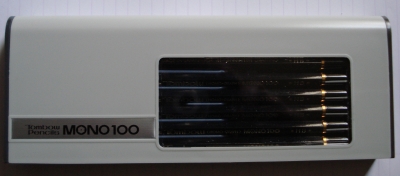
Here’s a photo of the Mono 100 with some other top Japanese pencils:
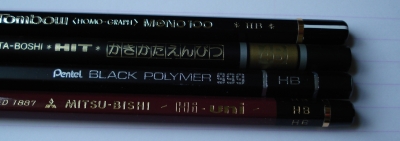
Mitsubishi Hi-Uni Photos
In response to a request, here are some more photos of the Mitsubishi Hi-Uni pencils and their packaging.
It’s a lot of packaging for a dozen pencils. The good thing is that this box seems to actually protect (as opposed to just house or congregate) the pencils. Even with several pencils removed, the remaining ones don’t roll about, due to an insert that separates the pencils. It seems much more useful for travel than just a loose pencil case.
Okay, on with the show.
Here is the green sleeve alongside the pencil box:
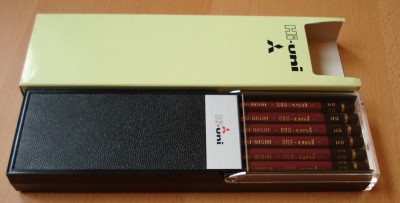
The green sleeve has a cutout that corresponds to a degree marking on the box:
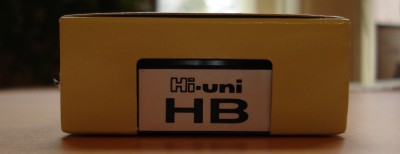
The box is black plastic with a clear one-third length lid that flips open:
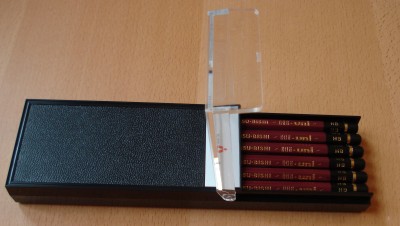
They’re a nice set of pencils:
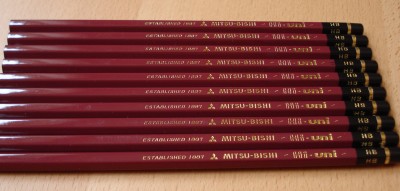
Here is Hi-Uni next to a Tombow Mono 100. Two great pencils.

Wide lead art pencils: The Lyra Ferby and Grafitkreide
Here are two really fun pencils that I found at a local art supply store.
The first is the Lyra Ferby Graphit 97100. It is a natural finish oversize triangular pencil. The length of the pencil is less than a standard pencil. The lead is also oversize.

This pencil is pure fun. The lead is very dark and smooth, of the same calibre as premium standard sized pencils. Although the pencil might be aimed at children, it makes sense that an art supply store (and a selective one compared to most in these parts) would stock this implement. You can’t help but start drawing or doodling with it.
It lets you do serious things with it, but if you don’t, that’s also fine.
The second pencil is also from Lyra, and it’s actually a pure stick or crayon of graphite with a paper wrapping. It’s identified as the Lyra 1772. This thing can draw some incredible lines. In 9B, it owns any page it touches, with it’s smooth dark markings.

But the fun doesn’t end there – there is a water-soluble variant, the Lyra 1773. Wrapped in blue paper (the 1772 has a black wrapper) , it’s slightly smaller in diameter.
You can dip it in water and start sketching – it creates an amazing silvery metallic finish. Or if your brush skills are up to the task, you can sketch first, and apply a brush with water. My attempts just smeared whatever I drew, but I’m sure a more skilled hand would succeed.
For a buck or two, I think these are a lot of fun.
